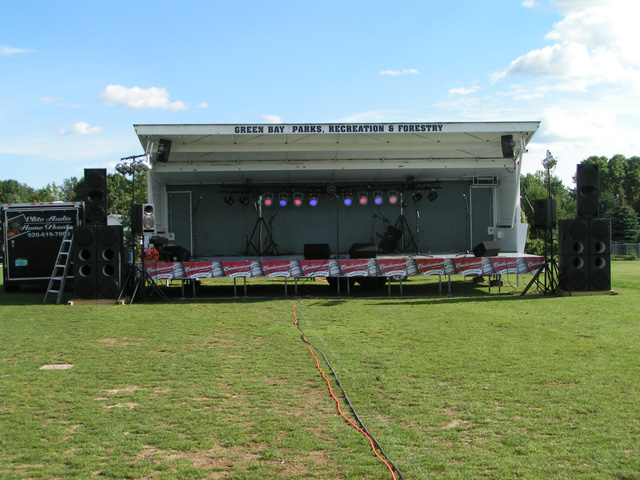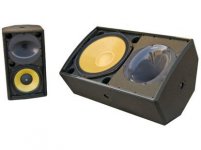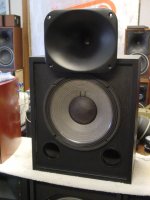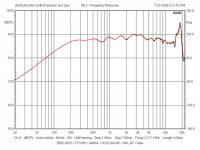Tom Danley said:Zilchlab, I am not sure what your apparent “thing” is with Earl but I would ask, have you ever measured / listened to a plain simple off axis horn like the JBL?
http://www.diyaudio.com/forums/showthread.php?postid=1880909#post1880909
This thread is about my "thing" with Earl, actually.
I sent him the $9.90 JBL waveguides to measure; he didn't much like the results, apparently.... 😉
Hi Tom,Tom Danley said:I am showing this, warts and all in a couple products I designed
Any chance you or someone from DSL could bring one of those products you designed to diyatl ?
cheers,
AJ
I guys,
Did you checked this new, nice looking, Kevlar yellow, ADAMSON 'GEDDES' POINT SERIE (Canada). Pretty scary.
http://www.dv2.fr/index.php/news/newsFull/idNews/25
Did you checked this new, nice looking, Kevlar yellow, ADAMSON 'GEDDES' POINT SERIE (Canada). Pretty scary.
http://www.dv2.fr/index.php/news/newsFull/idNews/25
Attachments
It is interesting to note that they didn't try to put the waveguide closer to the woofer, even if it is not axis-symetric.
But then it can be rotated
But then it can be rotated
I'm sure it's better than a stick in the eye, but I'm wondering if it even matches pattern in the horizontal. Any measurements?
Inductor said:I guys,
Did you checked this new, nice looking, Kevlar yellow, ADAMSON 'GEDDES' POINT SERIE (Canada). Pretty scary.
http://www.dv2.fr/index.php/news/newsFull/idNews/25
Here's a translation:
Thanks to investments in its new plant in Port Perry in Canada including a chain assembly speaker automated ADAMSON is now able to offer all the performance of exceptional products at realistic prices.
Culmination of years of experience, Adamson introduced the Point Series has been the subject of several patents.
The new Point Series is composed of
Item 8: LF 8''1''HF passive filtering
Item 12: LF 12''1.4''HF active or passive
Item 15: LF 15''1.4''HF active or passive
Item 115 Sub: 1 x 15''with crossover for use in conjunction with P8
Item 215 Sub: 2 x 15''
The design and ergonomics Point Series products can be used front or back for touring or installation applications. All products have the best technology Adamson. The transducers use kevlar membrane, Neodymium magnets. This provides a net gain of weight. The HF section is responsible for waveguide acoustic Geddes. The pavilion is rotating. All models have a base for walking. Finally, a wide range of accessories hanging allows for the wide variety of configurations.
The products will be available from late May
Issued by DV2
Tel 03 87 30 00 00
Dv2.fr
I'm wondering about the model with the 8" woofer. In my experience, the smaller midwoofers don't play well with horns in DI-matched two-ways. Lots of people want to go that direction because they think intuitively that the smaller cone can be run to higher frequency but in fact, the directivity doesn't match. If you crossover high enough to get the horizontal pattern to match, the verticals are hopelessly narrow. The forward lobe becomes too thin, separating it from large (unwanted) side lobes with closely spaced vertical nulls. When matching to a direct radiator, I wouldn't go smaller than 12".
Translation
ADAMSON is a manufacturer very innovating who contributed major shares to audio industry (6 patents deposited - 5 patents in progress). Amongst other things ADAMSON quickly was characterized by its scientific papers on the houses guides wave with the AES in collaboration with Dr. Earl Geddes. (Acoustic Waveguides - in Practice. J. Audio Eng. Ploughshare, Flight 41, N° 6,1993 June) Since its origin ADAMSON manufactures its own loudspeakers, the majority use membranes in kevlar whose rigidity and lightness exceed the traditional paper paperboard membranes.
Dr. G is getting name dropped.
ADAMSON is a manufacturer very innovating who contributed major shares to audio industry (6 patents deposited - 5 patents in progress). Amongst other things ADAMSON quickly was characterized by its scientific papers on the houses guides wave with the AES in collaboration with Dr. Earl Geddes. (Acoustic Waveguides - in Practice. J. Audio Eng. Ploughshare, Flight 41, N° 6,1993 June) Since its origin ADAMSON manufactures its own loudspeakers, the majority use membranes in kevlar whose rigidity and lightness exceed the traditional paper paperboard membranes.
Dr. G is getting name dropped.
Re: Translation
Brock Adamson and I have been good friends for almost twenty years. I designed his first waveguides for him, where, by agreement, my only compensation was credit for the design. Brock has found over the years that the core design that I did, which was elliptical, works very well and he has stuck with it. He continues to "do the right thing" and give credit where credit is due - which is a very rare thing the the audio world, most notably in "waveguides".
Monger said:ADAMSON is a manufacturer very innovating who contributed major shares to audio industry (6 patents deposited - 5 patents in progress). Amongst other things ADAMSON quickly was characterized by its scientific papers on the houses guides wave with the AES in collaboration with Dr. Earl Geddes. (Acoustic Waveguides - in Practice. J. Audio Eng. Ploughshare, Flight 41, N° 6,1993 June) Since its origin ADAMSON manufactures its own loudspeakers, the majority use membranes in kevlar whose rigidity and lightness exceed the traditional paper paperboard membranes.
Dr. G is getting name dropped.
Brock Adamson and I have been good friends for almost twenty years. I designed his first waveguides for him, where, by agreement, my only compensation was credit for the design. Brock has found over the years that the core design that I did, which was elliptical, works very well and he has stuck with it. He continues to "do the right thing" and give credit where credit is due - which is a very rare thing the the audio world, most notably in "waveguides".
Geddes was granted a patent on an elliptical horn/waveguide a couple years back. Not sure if there is prior art that the examiners missed or not. But whatever the IP rights and legal aspects are, I think it's a good idea. The most useful coverage pattern is usually asymmetrical, and the catenary flare profile prevents discontinuities and their associated reflections and impedance and response aberrations.
In the case of the Adamson speaker referenced above, I think the use of the elliptical horn/waveguide is sort of a marketing thing. I'm not sure it helps much, with the wide spacing between drivers and the ability to rotate the horn for horizontal orientation. It may look like a neat idea, but unless several speakers are being hung as an array, I woudn't want to lay the drivers side-by-side. It's probably a feature driven by the marketing department. I've noticed other companies have done that too.
This kind of configurable speaker allows vertical or horizontal orientation, providing a single speaker that can be used for both applications. It probably makes sense from a production standpoint. Personally, I would prefer two different models be made in this situation, because the two different applications are so different. An array made of several speakers is a completely different thing acoustically from a single speaker with a tweeter mounted above a woofer. They are different design strategies with different design goals. But then again, there is the matter of production, and that may be another reason for the rotatable horn.
I was asking for measurements a few posts back, but the more I think about it, we don't need them. We can probably assume that the polars aren't great. They surely can't be good when the horn is rotated for horizontal placement, not when used as a single loudspeaker. Then again, in an array, it's a different ball game.
In the case of the Adamson speaker referenced above, I think the use of the elliptical horn/waveguide is sort of a marketing thing. I'm not sure it helps much, with the wide spacing between drivers and the ability to rotate the horn for horizontal orientation. It may look like a neat idea, but unless several speakers are being hung as an array, I woudn't want to lay the drivers side-by-side. It's probably a feature driven by the marketing department. I've noticed other companies have done that too.
This kind of configurable speaker allows vertical or horizontal orientation, providing a single speaker that can be used for both applications. It probably makes sense from a production standpoint. Personally, I would prefer two different models be made in this situation, because the two different applications are so different. An array made of several speakers is a completely different thing acoustically from a single speaker with a tweeter mounted above a woofer. They are different design strategies with different design goals. But then again, there is the matter of production, and that may be another reason for the rotatable horn.
I was asking for measurements a few posts back, but the more I think about it, we don't need them. We can probably assume that the polars aren't great. They surely can't be good when the horn is rotated for horizontal placement, not when used as a single loudspeaker. Then again, in an array, it's a different ball game.
18sound XT1086
Has any of you worked with the 18sound XT1086 Constant Coverage Horn?
I believe I've seen it mentioned a few times, but has anyone here built anything with it?
The polars look nice, maintains pattern control down to below 2kHz (even in the vertical) and has reasonably compact mouth dimensions. With this, I imagine you could keep C-T-C spacing and crossover right to space nulls outside the vertical pattern, just like you saw in the little "vertical nulls" video I did.
Crossover around 1kHz to 1.5kHz somewhere, depending on the drivers chosen, and if you've placed everything on the baffle just right, the directivity should match in the horizontal plane and the nulls should be outside the pattern in the vertical plane.
Has any of you worked with the 18sound XT1086 Constant Coverage Horn?
I believe I've seen it mentioned a few times, but has anyone here built anything with it?
The polars look nice, maintains pattern control down to below 2kHz (even in the vertical) and has reasonably compact mouth dimensions. With this, I imagine you could keep C-T-C spacing and crossover right to space nulls outside the vertical pattern, just like you saw in the little "vertical nulls" video I did.
Crossover around 1kHz to 1.5kHz somewhere, depending on the drivers chosen, and if you've placed everything on the baffle just right, the directivity should match in the horizontal plane and the nulls should be outside the pattern in the vertical plane.
Re: 18sound XT1086
Seems like a bunch have them, but there's little reported on actually building with them.
[I'll do it right now w/2206H.... 😀 ]
http://www.jblpro.com/pub/obsolete/4646a.pdf
Wayne Parham said:Has any of you worked with the 18sound XT1086 Constant Coverage Horn?
I believe I've seen it mentioned a few times, but has anyone here built anything with it?
Seems like a bunch have them, but there's little reported on actually building with them.
[I'll do it right now w/2206H.... 😀 ]
http://www.jblpro.com/pub/obsolete/4646a.pdf
This kind of configurable speaker allows vertical or horizontal orientation, providing a single speaker that can be used for both applications. It probably makes sense from a production standpoint. Personally, I would prefer two different models be made in this situation, because the two different applications are so different. An array made of several speakers is a completely different thing acoustically from a single speaker with a tweeter mounted above a woofer. They are different design strategies with different design goals. But then again, there is the matter of production, and that may be another reason for the rotatable horn.
I think this is desirable in a mobile rig where you may want to use a speaker as either a mid-high, booth monitor or a floor wedge, especially if it is semi-trapezoidal..
col.
John from aespeakers has used the XT1086 in pro systems -- the two small speakers, inside the main monitors, aimed in for center fill.
http://www.aespeakers.com/phpbb2/viewtopic.php?f=3&t=1690

http://www.aespeakers.com/phpbb2/viewtopic.php?f=3&t=1690

- Status
- Not open for further replies.
- Home
- Loudspeakers
- Multi-Way
- Horn vs. Waveguide


